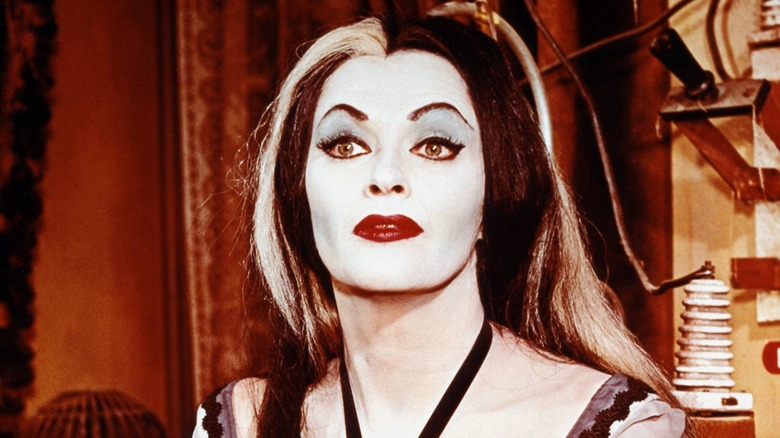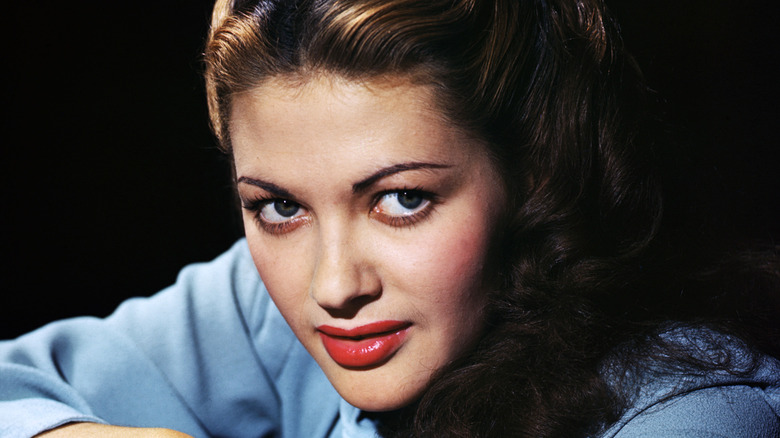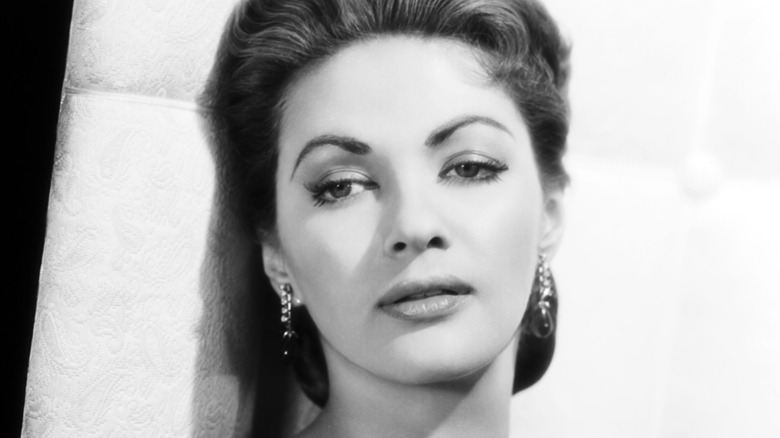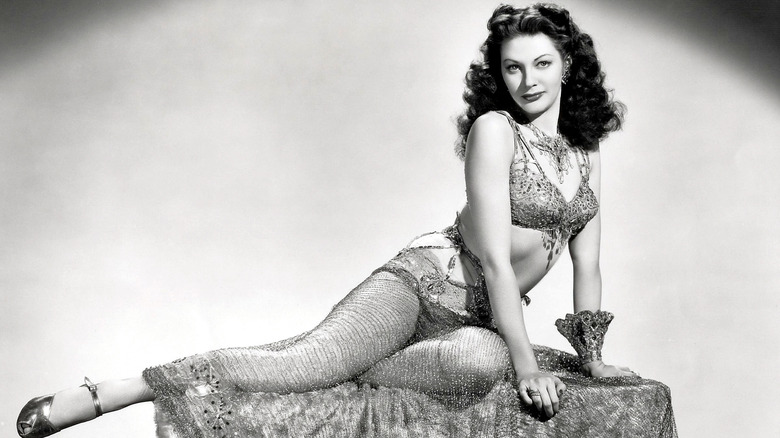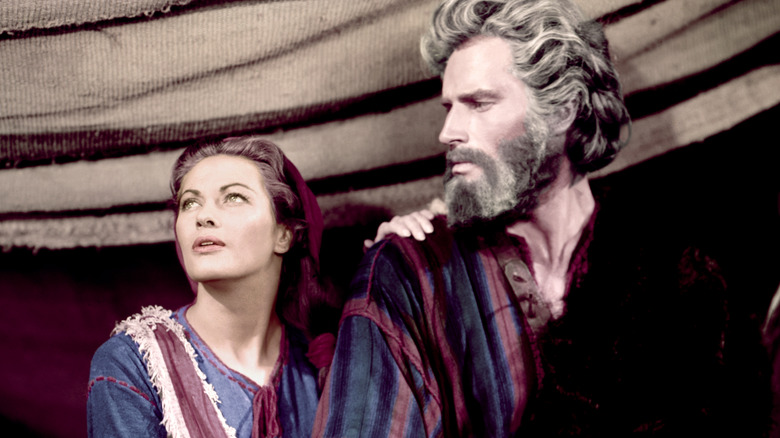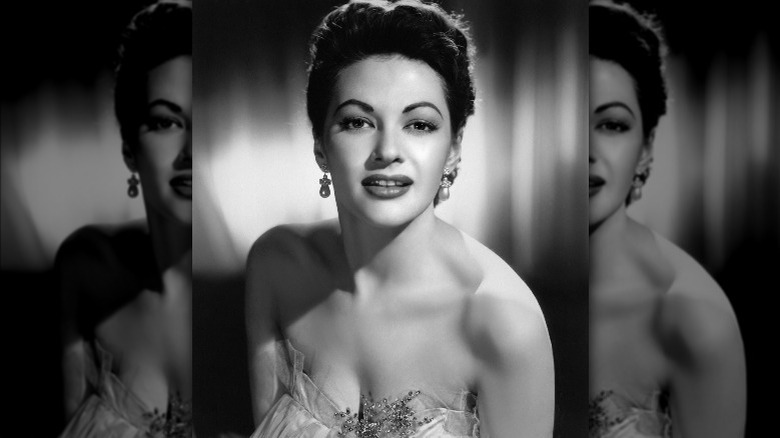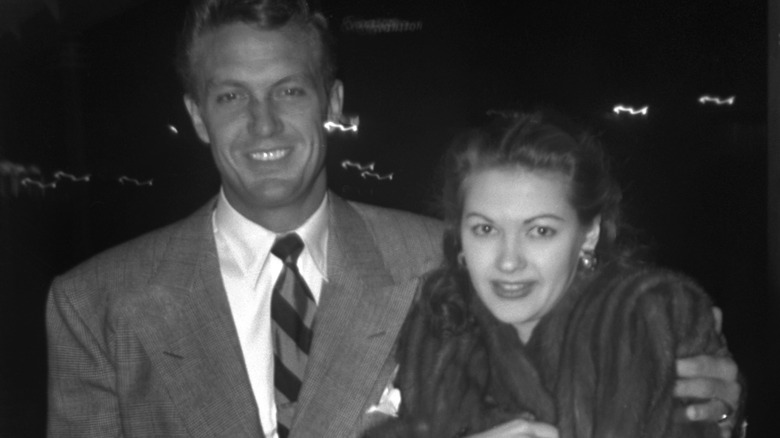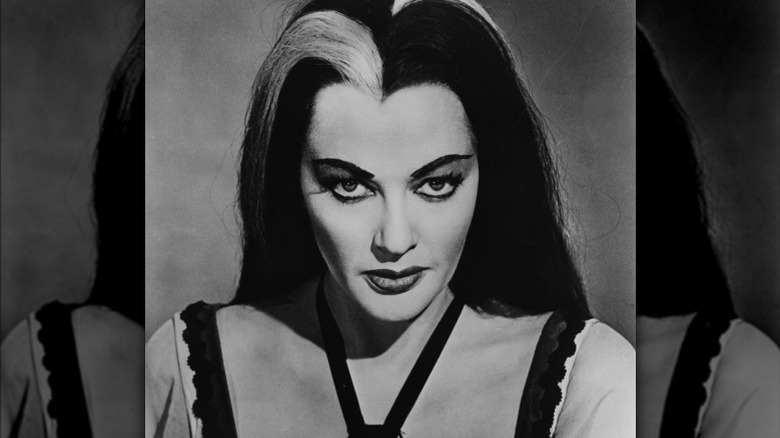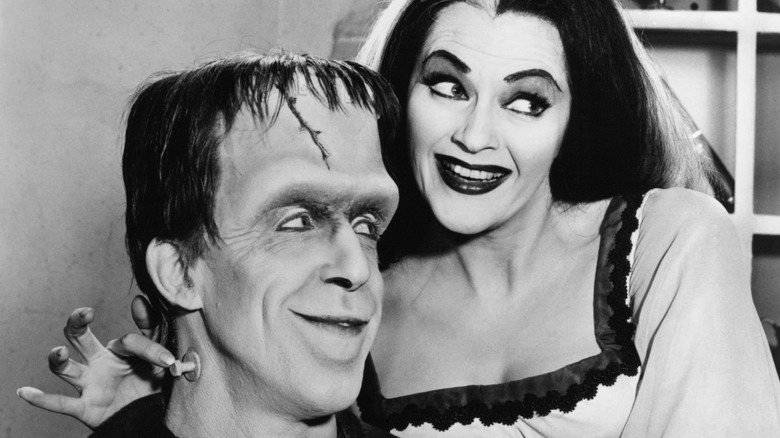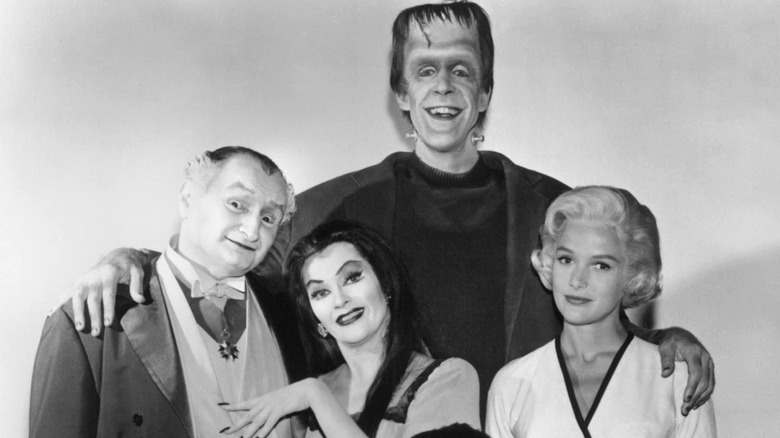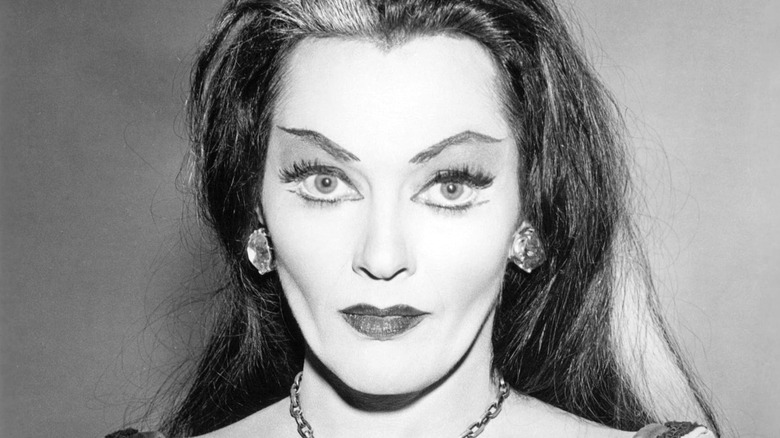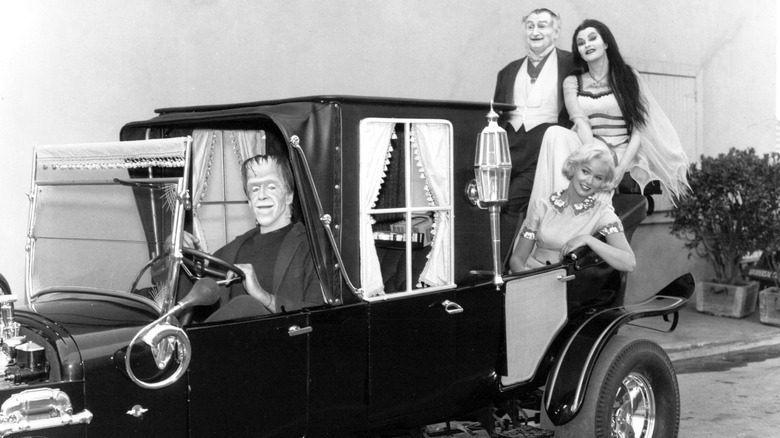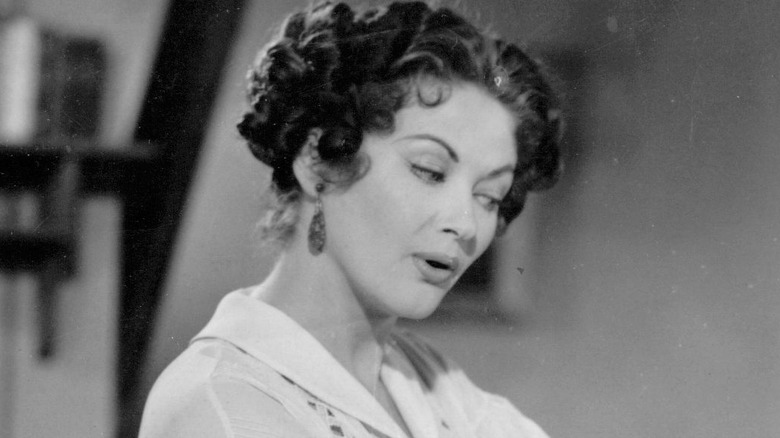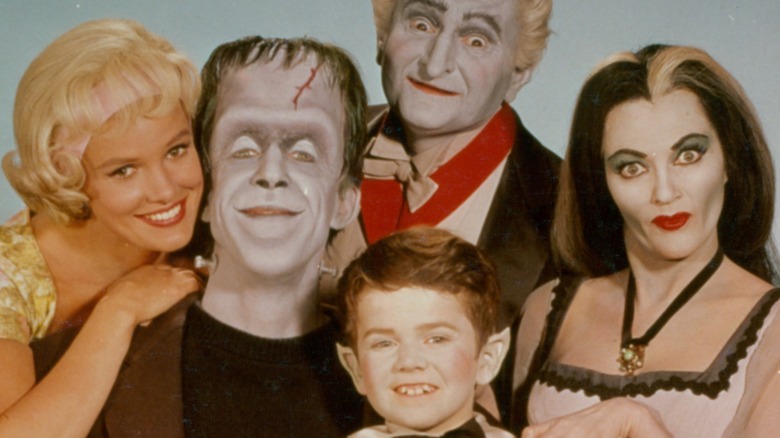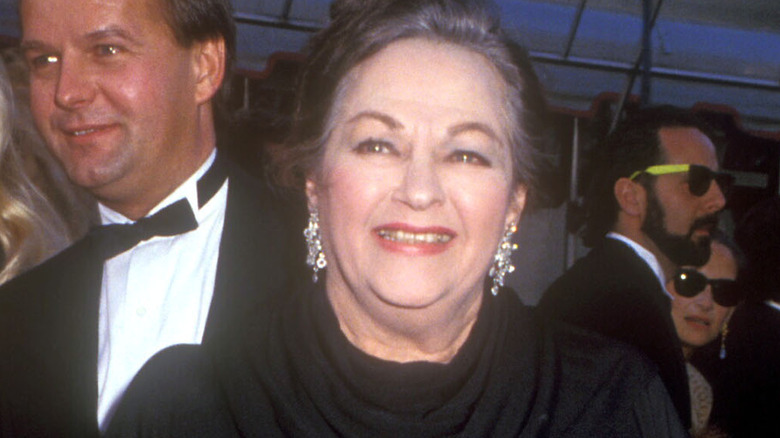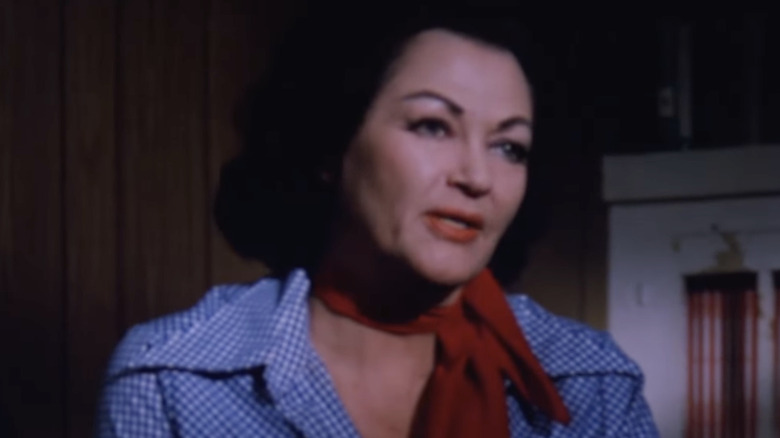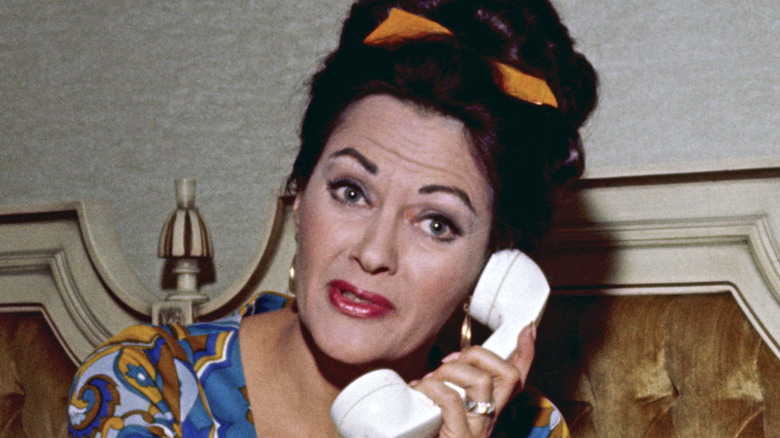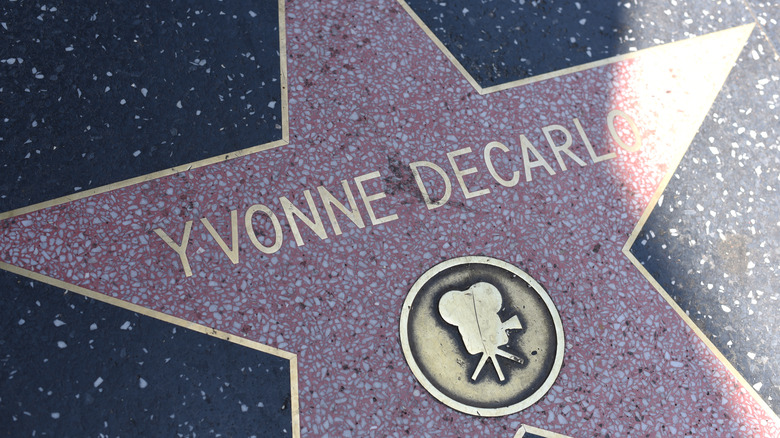The Untold Truth Of Yvonne De Carlo
She's certainly best known today for her role on a perpetually repeated, high-concept '60s television sitcom hit, but Yvonne De Carlo had already built a varied, impressive, and illustrious career in the epic, exotic films churned out by Hollywood in the 1940s and 1950s. Forever TV's bride of Frankenstein's creature, as the monstrous, motherly, and goofy Lily Munster on "The Munsters," De Carlo made an impression on small-screen viewers both young and old, or rather the ones who remembered her from her much different roles in huge movies including "The Ten Commandments," "The Sword and the Cross," and "Band of Angels."
De Carlo was a star two times over, and a show business survivor, with a career that lasted from the days of the studio system to '80s-era cheese. Also a singer and a dancer, De Carlo did it all, and she became the toast of Hollywood along the way.
She was supposed to be a child star
The actor who found international fame in films and sitcoms as Yvonne De Carlo was not born with that name. She was born in 1922 in Vancouver, British Columbia, as Margaret Middleton. The future star's mother, who'd left home at 16 to become a ballet dancer, also harbored an ultimately never-fulfilled wish of becoming a movie star. Seeking to pass those ambitions on to her daughter, or to at least live vicariously through her, she named her child Margaret so that she could refer to her by the nickname Peggy — as in Baby Peggy, a popular child star of the silent film era.
When Margaret, or Peggy, was 3 years old, her salesman father walked out on his family. Embroiled in a few scams that went wrong, William Middleton left Canada by ship and said he'd collect his family when he'd settled down; that was the last Margaret ever heard or saw of him. "My own assumption is that he died before he had the chance to discover that his Baby Peggy had become a Hollywood actress, or I think he would have tried to contact me," the actor wrote in "Yvonne: An Autobiography."
She spent her youth in Canada and Hollywood and was raised in part by her grandparents
Determined to make her daughter the entertainment star that she never was, Marie De Carlo took a teenage Margaret Middleton from Vancouver to Los Angeles in the 1930s. Looking to supplement her daughter's exhibited natural singing talent, Maria enrolled her daughter in a dance academy, which she attended in addition to a regular school. Maria worked as a server and took on other gigs to support the two until her daughter was discovered by Hollywood. When their visas ran out without a breakthrough, the pair returned to Vancouver, a cycle they went through three times.
Whenever they were back home in Vancouver, both women lived with Maria's parents, Michael and Margaret De Carlo. It's their last name that Margaret Middleton would use as half of her stage name, adding the De Carlo to her middle name, Yvonne, to create Yvonne De Carlo.
'Salome' made her a star
Yvonne De Carlo's breakout role, and the one which got her a long-term contract with Universal Pictures, was 1945's "Salome, Where She Danced." Utilizing her talents of singing, dancing, and acting, De Carlo portrayed a 19th-century Austrian refugee who meets and falls for an American criminal who reminds her of her dead true love. The project was designed for star Maria Montez, who was unable to make the film, so producer Walter Wanger waged a talent search and publicity campaign to find "the most beautiful girl in the world" to star, as per "Walter Wanger: Hollywood Independent," by Matthew Bernstein. His choice: De Carlo, a Paramount contracted actress with a few bit parts to her name. She won the starring role out of a field of 20,000 women.
Once Wanger made his decision, he pulled out all the stops to create interest around the movie and De Carlo. He leaked pictures of De Carlo to newspapers with a rather mysterious story that a service member in the Royal Canadian Air Force reached out to him in a grassroots campaign to get De Carlo in the film, according to De Carlo in "Yvonne: An Autobiography."Of course it was a publicity stunt on the back of the talent search — which De Carlo had already sewn up. And the RCAF connection was her cousin.
How she moved from Hollywood cheese to epic Bible movies
Beginning with "Salome, Where She Danced" in 1945, Yvonne De Carlo became Universal Studios' go-to actor to play vampy temptresses and duplicitous femme fatales in films a little salacious and marketed as exotic. The Canadian actor played women from many races and cultures in films like "Song of Scheherazade," "Slave Girl," "Casbah," "River Lady," and "The Desert Hawk," along with big roles in various 1950s Westerns.
Solidly a stalwart of popular but not terribly well-regarded pictures, De Carlo moved into more prestigious fare when she was personally selected by Academy Award-nominated director Cecil B. DeMille to portray Sephora, wife of Moses (Charlton Heston), in the 1956 biblical epic "The Ten Commandments." He'd take notice of De Carlo in a flop she'd starred in back in 1953. "I had done a picture at Metro titled 'Sombrero' which wasn't too much of a hit. But I had portrayed a saintly type of woman similar to what DeMille had in mind for Sephora," De Carlo told syndicated columnist Hedda Hopper (via The Spokesman-Review). "He saw the picture, was very much impressed, and promptly said: 'You're it.'" "The Ten Commandments" received seven Academy Award nominations and wound up the highest-grossing film of 1956.
Yvonne De Carlo recorded an album with John Williams
Yvonne De Carlo wasn't just an actress and dancer. She also had a beautiful singing voice, and she shared it with the world when she decided to record an album. "Yvonne De Carlo Sings" was released in 1957 and consisted of 10 tracks, and some of the songs included are "Blue Moon," "End of a Love Affair," and "Little Girl Blue" (via Discogs).
The album was recorded in collaboration with John Williams, who went by the name John Towner before he became known for his iconic film scores. Back then, Williams had just started working in Hollywood as a studio pianist for a few movies, according to Britannica. John Williams conducted the orchestra that provided music in De Carlo's tracks. Later on, Williams would be known for the musical scores he composed for films, such as "Jurassic Park," "Schindler's List," "E.T.: The Extra Terrestrial," and many others.
She wasn't repressed
In the staid, socially conservative United States of the mid-20th century, it simply wasn't deemed proper for an unmarried woman, especially a public figure like a famous actor, to be open and frank about the physical side of her romantic life. For example, movie star Loretta Young became pregnant during a non-marital dalliance with Clark Gable and with the assistance of her Hollywood handlers, made it appear that she'd adopted her own biological child. But in keeping with her movie persona as a captivating seductress, Yvonne De Carlo allowed herself to be marketed as a very eligible woman who was seen in public, and written about in gossip columns, with a long succession of suitors.
Many of these relationships were short-lived, but they were authentic and passionate. In her 1987 memoir "Yvonne: An Autobiography," De Carlo thoroughly and explicitly detailed about two dozen such encounters with famous and powerful men. "It was so spontaneous and so explosive, I thought I was playing a scene from a blazing romantic novel," she recalled of what happened the night of her first date with Burt Lancaster. "We somehow managed to consummate a relationship, and it wasn't bad. In fact, it got better as time went on. It might have been on the clinical side, but that was the way with Howard Hughes," De Carlo wrote of her affair with the pilot and millionaire. Her post-Hughes rebound fling: Robert Stack. She also took up with opera singer Cesare Siepi and Prince Aly Khan of Persia.
She took the role of Lily Munster for financial reasons
By the 1960s, Yvonne De Carlo's Hollywood career wasn't as active. She had fewer jobs and took roles in B-movies as well as guest appearances on TV shows. It was in 1962 when the actress' life took a downward spiral. Her husband, stuntman Bob Morgan, got into a horrific accident while filming the movie "How the West Was Won" from MGM. He was run over by a train on set and lost his left leg as a result. The couple sued MGM for the accident, but it was deemed that the production company had no fault in it.
Medical expenses were piling up, and De Carlo worked hard to cover the bills. She took to working in nightclubs, but she was slowly getting deeper into debt. It was then that Universal Pictures offered her the role of Lily Munster in the new sitcom that was being developed. Desperate for work, De Carlo signed a contract to play the role, despite the character being far from what she typically portrayed on screen. Little did she know that Lily Munster will be the character she will be best known for.
She riled her Munsters co-stars
Of the three adult cast members on "The Munsters," two were closely associated with their TV work — "Car 54, Where Are You?" stars Fred Gwynne and Al Lewis. The other, Yvonne De Carlo, was a movie star whose dramatic career was on a descent from its peak in the 1950s. Gwynne and Lewis weren't happy with her casting. "We went down to the producers and screamed bloody murder," Lewis said in "The Munsters: A Trip Down Mockingbird Lane," by Stephen Cox. "Fred and I thought she would not be right in the part at all. Experience told us we were wrong." Nevertheless, De Carlo acted the part of the aloof movie star in the early days of the series. "Yvonne played better-than-thou for a while," Gwynne said in 1984 (via "The Munsters: A Trip Down Mockingbird Lane"). De Carlo would purposely show up late during filming, pausing production as cast and crew awaited her arrival.
In the middle of the first season of "The Munsters," actor Beverley Owen abandoned the role of Marilyn Munster, and producers replaced her with Pat Priest, who quickly earned De Carlo's animosity. "I remember Yvonne saying to me one day, 'There's one thing I want you to know, young lady. Don't you ever upstage me!'" Priest said in "The Munsters: A Trip Down Mockingbird Lane." "At that point I didn't know what I had done. The director had asked me to step forward," Priest explained, adding that her co-star eventually grew friendly toward her.
She was a late addition to The Munsters
Lily Munster on "The Munsters" is Yvonne De Carlo's most famous role, but she wasn't the producers' first choice, or even the first actor to inhabit the character. The pilot episode of "The Munsters" was taped in early 1964 and starred Joan Marshall as Lily. CBS ordered the show to series, provided some changes were made, namely replacing Marshall. Network executives feared that Marshall's look and portrayal of Lily bore too many similarities to Morticia Addams on ABC's similar mid-'60s monster comedy "The Addams Family."
Producers Joe Connelly and Bob Mosher auditioned many actors, ultimately deciding on Yvonne De Carlo, who wasn't initially on their radar because she was so closely associated with big-screen projects. Adding a more maternal quality to the character, not seen in Marshall's take, she got the role of Lily Munster and starred in two more pilots before "The Munsters" officially entered production.
She had major reservations about The Munsters
Yvonne De Carlo may have agreed to portray a monster on a sitcom, but she wasn't necessarily or immediately excited about it. "I must admit that I thought very carefully before deciding to do this show," De Carlo said to the Los Angeles Times in 1964 (via "The Munsters: A Trip Down Mockingbird Lane"), a few months after "The Munsters" debuted. "Because once you sign the contract, you're stuck." Her apprehension grew when she contacted the makeup team to find out what she'd be in for on a daily basis and what the desired effect would look like. "When they said I would have a green face with sunken cheeks, I began to worry."
James Bawden, a reporter who interviewed De Carlo to promote a TV series in 1975, claims that the actor had a breakdown when she first transformed into Lily Munster. "She said when they put her in the green makeup, she burst into tears," Bawden told Fox News. "She said, 'So it's come to this?'" De Carlo soon came to accept and appreciate the role. "She went on, 'In Hollywood, you have to roll with the punches if you want to keep working.'"
De Carlo also felt significantly better about her new high-profile role when she realized that the "Munsters" crew had no plans to make her look hideous onscreen. "They decided to glamorize me," she said to the LA Times. "My makeup doesn't take longer than a complete glamour makeup for the movies."
Yvonne De Carlo drove a customized Jaguar sedan
According to her son, Yvonne De Carlo loved watching horror movies. "She used to yell 'spooky movie,' and we'd run to watch them with her," her son said via the Los Angeles Times. In fact, she loved horror so much that she decided to customize her personal car with creepy decorations. It was during her time working on "The Munsters" that De Carlo bought a 1965 Jaguar Mark X.
The actress wanted a fun vehicle to drive, so she decided to have it decked with ghoulish elements. George Barris, who helped customize the car, said, "She was a wonderful lady and a car buff. She loved the show so much that she incorporated it into her life, her own car," as reported by Tahoe Daily Tribune. The Jaguar had spider web hubcaps, a black sunroof, a gargoyle hood ornament, a Dracula crest, and custom gold coffin rails. However, the actress had to sell her beloved car, as it was repeatedly vandalized by fans who wanted to have a souvenir.
Yvonne De Carlo made a splash on Broadway
Having made it as a big movie star in the 1940s, and a prominent television presence in the 1960s with "The Munsters," Yvonne De Carlo set out to conquer another medium in the 1970s. In doing so, she enjoyed a major comeback.
Following a successful four-month stint in 1968 and 1969 as Dolly Gallagher Levi in the touring version of the smash hit musical "Hello, Dolly!", De Carlo landed the part of Carlotta Campion in the 1971 original Broadway production of "Follies," with music and lyrics by the esteemed Stephen Sondheim. The show would earn 11 nominations at the Tony Awards and win seven. None of those were for De Carlo, but she made her mark on the musical theater classic as the originator of the modern Broadway standard "I'm Still Here," sung from the point of view of a cynical and seasoned veteran entertainer.
She had a long friendship with Butch Patrick well after The Munsters
After a 70-episode, two-season run, CBS canceled "The Munsters" in 1966. Initially, the cast didn't remain particularly in touch, not until some of the actors reunited for the 1981 made-for-TV movie "The Munsters' Revenge." For Yvonne De Carlo, one friendship bloomed in the 1990s, after she appeared as a guest on Vicki Lawrence's daytime talk show "Vicki!" and producers surprised her with a visit from Butch Patrick, who played De Carlo's TV son, Eddie, on "The Munsters."
"After that, we became friends," Patrick told ComingSoon. "I started going up and visiting her and she was somewhat of a recluse, living in North Los Angeles." Patrick made sure that De Carlo had her needs met, setting up deliveries of food and movies and updating her on modern showbiz happenings. Patrick and De Carlo also spoke and met fans at sci-fi conventions together and turned out cameos in what would be one of De Carlo's last acting roles, the 1995 TV movie "Here Come the Munsters."
She fought with her memoir's publisher
In April 1987, Yvonne De Carlo spilled a lot of secrets about her life and the lives of the celebrities who populated Hollywood in its "Golden Age" of the 1940s and 1950s. With assistance from writer Doug Warren, De Carlo published her tell-all memoir for St. Martin's Press, "Yvonne: An Autobiography." As was once customary for actors and celebrities, De Carlo ceded most of the writing of what went to press to Warren, but it wasn't for a lack of effort. "As far as my writing is concerned — I tried. But I think that when they have an established author, they usually use his stuff more," De Carlo explained of St. Martin's to the Orlando Sentinel. "I put a lot of stuff in there, but they didn't use much of it."
As a result of publisher interference, the completed "Yvonne: An Autobiography" includes very little information or reflection on the actor's upbringing and early career milestones. Instead, the book became primarily a mildly scandalous series of anecdotes about De Carlo's many famous lovers and exes. "They insisted on that. I didn't want to be nasty." De Carlo and Warren describe in great detail her encounters with more than 20 celebrity men, including Burt Lancaster, Howard Hughes, and Robert Stack. "Yvonne: An Autobiography" is dedicated to "All the kings, princes, lords, millionaires, and truck drivers I have known."
Late in life, she turned to camp
By the 1980s, years of reruns of old episodes of "The Munsters" left Yvonne De Carlo associated strongly and primarily with the role of Lily Munster. The historical dramas and biblical epics in which she'd starred in the 1940s and 1950s had fallen out of favor anyway, so in the latter years of her career, De Carlo leaned into the "Munsters" lane, taking on roles in both cheeky horror movies and family friendly fare.
In the late 1970s, De Carlo landed parts in scary, gory projects like "Satan's Cheerleaders," "Guyana: Cult of the Damned," and "The Silent Scream." After a reprise of her most famous gig in the 1981 made-for-TV movie "The Munsters' Revenge," De Carlo returned to horror by way of "Play Dead," "A Masterpiece of Murder," and "American Gothic." De Carlo wound down her career in the '90s with brief appearances on the TV shows "Dream On" and "Tales from the Crypt," and two final made-for-television films in 1995: the Disney-produced "The Barefoot Executive" and a would-be "Munsters" called "Here Come the Munsters." De Carlo's role was a cameo as a restaurant patron, handing off the character of Lily to Veronica Hamel.
Tragedy characterized Yvonne De Carlo's final years
In what would turn out to be the last decade of her life, Yvonne De Carlo endured a string of personal and familial tragedies that profoundly affected her health and well-being. With her husband Robert Morgan, De Carlo raised two sons, Bruce and Michael Morgan. In 1997, Michael suffered a stroke, and the brain damage he incurred killed him at the age of 39. "It just preyed on her mind," author James Bawden told Fox News. "All she would talk about was her son." Arguably, the stress and distress over the premature death of her son was a factor in De Carlo also enduring a stroke, just one year after her son experienced a similar medical episode. Already largely retired from acting, De Carlo was unable to ever work in film or television again.
De Carlo moved into the charitable Motion Picture and Television Country Home and Hospital in Woodland Hills, California. In 2007, the 84-year-old star of screens big and small died. The cause: natural cause, attributed to old age.
She has two stars on the Hollywood Walk of Fame
Yvonne De Carlo has two stars on the Hollywood Walk of Fame — one for the Motion Picture category and the other for Television, per Walk of Fame. She appeared in more than a hundred movies in her decades-long career, and her most notable roles include Anna Marie in "Salome, Where She Danced," Amantha Starr in "Bond of Angels," and the wife of Moses, Sephora, in "The Ten Commandments." In regard to her iconic role as Lily Munster, De Carlo said, "It meant security. It gave me a new, young audience I wouldn't have had otherwise. It made me 'hot' again, which I wasn't for a while" (via Tahoe Daily Tribune).
Although "The Munsters" was on air for only two seasons, the sitcom, as well as De Carlo's role, made a mark. Kevin Burns, a producer and the actress' friend, stated, "I think she will be best remembered as the definitive Lily Munster. She was the vampire mom to millions of baby boomers. In that sense, she's iconic."
